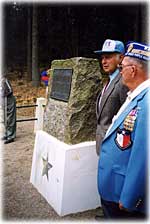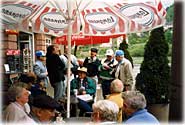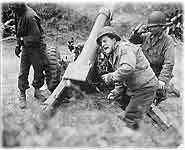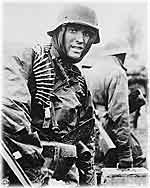|
|
| Our
next stop was Fraize where we presented the Mayor and the people of
the town with a beautiful plaque in the name of the 36th Infantry
Division Association. There we had a very nice lunch. During the
ceremonies welcoming us to Fraize the Mayor presented everyone in our
group, including the family members, with a certificate. |
| After
lunch and ceremonies we boarded onto the bus and we were taken
to the monument dedicated to the 442nd Infantry Regiment and
the 36th Division.
Here
is where the 442nd finally broke through to the 1st Battalion
of the 141st Infantry Regiment that had been surrounded by the
enemy. We have all heard of the so called "Lost
Battalion" who knew where they were all the time, but I
suppose the name was adopted because if the 442nd or some
other unit had not broken through the enemy lines, the
Battalion running out of ammunition and supplies would have
been lost. The 442nd lost many lives, but like good soldiers
did their job without thought of the sacrifices they had to
give to get the job done and they certainly accomplished their
mission. Three of the Veterans in our group laid a wreath at
the foot of the monument and the Ladies of our group then
placed their own wreath in the name of peace. Again, a
beautiful and meaningful ceremony we were most fortunate to be
a part of.
We
boarded our bus to again return to Fraize and the Hotel di
Centre for lunch which featured the specialty of the area
which was some delicious ham. The lunch was hosted by the town
officials. After this very fine meal and wonderful
hospitality, as usual, back on the bus over the Vosges into
the Rhine valley and the Colmar
pocket. |
|
 |
| Leonard
Knear and Ray Wells during the ceremonies at
the location of the monument honoring the
442nd Infantry Regiment (Niesi) |
|
|
|

|
| Group of 36th
Division Vets and family members taking time out from the fast moving tour. |
|
|
Arriving
in Colmar we were booked into the Hotel Mccure. Then we had a day
to relax and do whatever we wanted to do. It was Sunday so most of
the stores were closed and most of us gathered at a side walk cafe
which was located in the center of the old post of town and was
surrounded by very picturesque buildings. Here we sampled the
local wine and beer and had lunch, Some even tried escargot and
said they were delicious.
Seemed
like everyone retired early after a fine dinner at the hotel.
After a nice rest and another great breakfast, we were off to
Riquewihr. The old Vets began to loosen up and share their war
time experience with the rest of us via the speaker on the bus.
Atop Marie Pass, the cement bunkers which the Germans built to
serve as roadblocks were still visible. Every one of them had to
be destroyed before our troops could move on to the next
objective. |
|
 |
| American howitzers shell German forces retreating near
Carentan, France. Still Pictures Branch.
National Archives at College Park, Maryland. |
|
|
|
On
the way to Koenigsbourg Castle we passed a cafť high on the mountain.
Harold Horning, of our group, related his experience during the battle
at this locale. Harold was a forward observer for the Artillery and
had established his observation post in the cafe which overlooked the
whole valley. He could see for miles. The cafe was run by a married
couple who employed three maids who were available to take care of Ks
room. When after three weeks and it was time for him to be relieved of
this strenuous and dangerous duty Harold the brave soldier that he
was, volunteered for unlimited duty at this very post. We were so
proud of one of our own that took on a duty such as this. When a
General arrived for an inspection, Harold had just successfully
directed fire on a target which turned out to be an enemy ammunition
dump and Harold was in solid with this General and he could do no
wrong.
|
While we were
rewarded with this tale of bravery our bus continued to the top of the
mountain where the medieval fortress of Haut-Koenigsbourg had been
built several hundred years before. Here, I think I should tell you
something about the castle and how the castle fit into the battle
plans of the 36th. "After fighting through the remains of Hackelís
Grenadiers cross-country from La Croix-aux-Mines, two companies of the
3rd Battalion, 142nd Infantry Regiment, outflanked and surprised the
Germans, routing them and capturing 170 with a loss of only two
Americans slightly wounded. Soldiers of the 3rd Battalion occupied the
medieval fortress without resistance and beat back a 16th
Volksgrenadier Division counterattack two days later.
One of our
group, Cewrin Johnson, was one of the men who climbed the mountain and
was admitted by the care-taker after applying rifle butts to the heavy
door. He told us that to ward off the bitter cold and not having
blankets the squad he was with pulled the ancient and very valuable
drapes from the walls of the castle to cover themselves. How did they
know, these fighting GIís, that those wall coverings were priceless.
The fortress building itself covered, I imagine, at least an area of
two city blocks and was very impressive in its size and architecture.
On to
Kientzheim where Cewin Johnson and his good Buddy, Curtis Alley, who
were in the same Company, wanted to find the place where Cewin as a
forward scout found a German tank waiting to ambush his Company. The
tank did fire on them but because Cewin had been able to warn his
Company, there were no casualties. We found the exact spot where the
German tank, and another plus was marked up for our tour guide Dennis
Ross. |
|
 |
| A Nazi soldier, heavily armed, carries ammunition boxes forward with companion in territory taken by their counter-offensive in this scene from captured German film. Belgium.
December, 1944. Still Pictures Branch.
National Archives at College Park, Maryland. |
|
|
|
|
|
|
 |
 |
 |
| This World War
II history is sponsored and maintained by TMFM |
|
|
|
|

